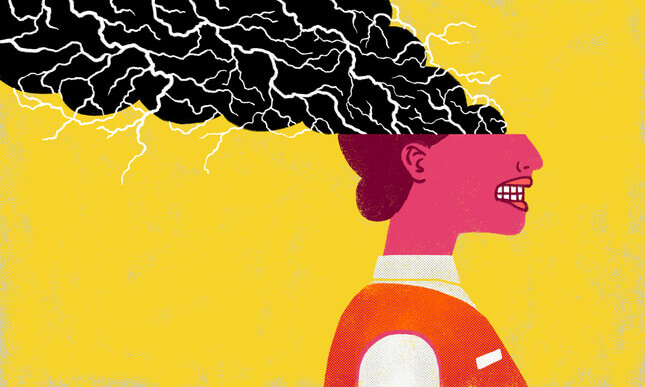Why Working Women With Migraines Suffer in Silence


I had my first migraine when I was 10, on vacation with my dad at a resort in France. Being with my dad and his wife always meant pretending to cope, which turns out to be good preparation for life as a migraine sufferer. The migraine got serious while I was trying to drink a Coke float. The fake whipped cream on top, which I would under normal circumstances squirt straight into my mouth, revolted me. I threw up a couple hours later, after waking in the dark, crying. I haven’t had a Coke float since.
Since I was 16, I’ve averaged one full-blown migraine a week. It’s often more, and I usually have a headache at least a few days every week. If I catch it early, sometimes ibuprofen or Excedrin and sleep can work. If I don’t, I take Maxalt tablets or Zomig nasal spray, which burns my nose and makes my entire body sensitive to touch and gives me nightmares, but when I wake up, I’m able to sit up and slouch to the living room. The pain is still there, but it no longer has the raging, demonic quality of a migraine. It’s tamed, like a werewolf becoming a regular-ass wolf that still kinda wants to kill you.
Without prescription medications, I can’t imagine my life. On the rare occasion that I have to suffer through a migraine without them, I spend hours lying on my side in the dark, trying desperately not to move or even breathe, listening to Frasier on Netflix; or sometimes forcing myself to get up and walk around, crying and shivering, trying to make myself throw up through the agony of moving, and get it over with more quickly. My boyfriend can’t even stroke my hair without hurting me.
I’ve tried every class of preventive medication and found none were good enough to make it worth the side effects, which have ranged from feeling sluggish and generally dumb to losing my hair in clumps. I get Botox injections every 12 weeks, which help a bit. I don’t drink alcohol or coffee, but every other trigger that some old guy tells me to avoid seems not to matter. Nevertheless, they persist.
Yet my situation is unimaginably good compared to many, many other women with migraine, because of one key difference: paid leave. I can take a day off when I have a migraine. It sucks, and it makes me a worse journalist—this piece itself has been delayed about two weeks because I’ve had so many migraines—and I feel guilty and anxious every time, but I don’t lose a day’s wages. For millions of women—and migraine affects women at a much higher rate than men—that isn’t the case. They struggle through their work to make ends meet, and they hide their suffering. They go on because they have to.
Migraine is a shockingly common condition, considering how little is known about what causes it (the current thinking is changes in brain chemistry). It is not, as anyone who’s had one will tell you, ‘just a headache.’ It’s a vicious collection of miserable symptoms, which can include nausea and vomiting, obscured vision, tingling in the hands and feet, or even aphasia, the loss of speech. It is often deeply debilitating. Symptoms vary across individuals. Some people don’t even get the characteristic head pain. 37 million Americans suffer from it, with around 2-3 million of those being chronic sufferers, defined as 15 or more headache days a month.
There’s no mandatory paid sick leave in the U.S.. People with low incomes are less likely to have paid leave, and desperately needing each paycheck makes it harder to take unpaid leave. They’re also less likely to have good insurance, or even any insurance, making it harder to access necessary medications and the care of a neurologist. Migraine is also more prevalent among low-income people: 18 percent of women in the United States suffer from migraines, but 37 percent of women with incomes below $22,500 get migraines.
Depending on the severity of the condition, migraine sufferers may be protected under the Americans with Disabilities Act (ADA), meaning employers have to provide reasonable accommodations like a dark room. But the burden falls on individual migraine sufferers to make sure their employers are following the rules: Do they have the resources, and the mental and physical energy, to take their employer to court if their boss won’t provide a dark room for them? A 2012 decision by the Tenth Court of Appeals ruled that a migraine sufferer working in a doctor’s office was not covered by the ADA because her condition was only aggravated by that particular job—essentially, the court was telling her to get a different job that didn’t cause migraines. That decision didn’t mean migraines were not a disability under the ADA, but it did establish a stricter test for proving that an individual’s migraines are disabling.
Migraine sufferers face a similar problem in applying for Social Security benefits. Migraine is not listed by the Social Security Administration (SSA) in its “blue book,” the list of medical conditions that it uses to determine whether applicants for disability payments are eligible. Robert Shapiro, a neurologist at the University of Vermont and a member of the Board of Directors of the American Migraine Foundation, told me that migraine sufferers can be eligible for disability payments, but the condition’s absence from the listing means patients have to show that their impairment is comparable to a condition that is listed; this usually means epilepsy.
-

-

-

-

-

-

-

-

-

-

-

-

-

-

-

-

-

-

-

-

-

-

-

-

-

-

-

-

-

-

-

-

-

-

-

-

-

-

-

-

-

-

-

-

-

-

-

-

-

-

-

-

-

-

-

-

-

-

-

-

-

-

-

-

-

-

-

-

-

-

-

-

-

-

-

-

-

-

-

-

-

-

-

-

-

-

-

-

-

-

-

-

-

-

-

-

-

-

-

-

-

-

-

-

-

-

-

-











































































































